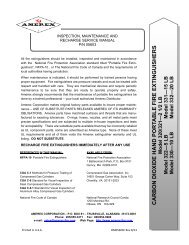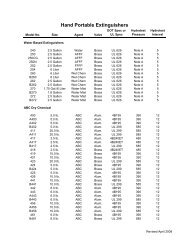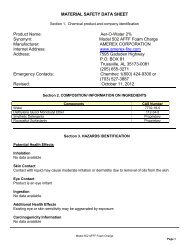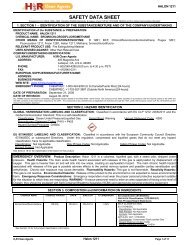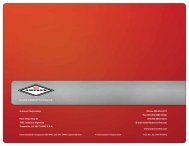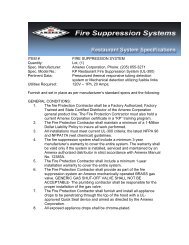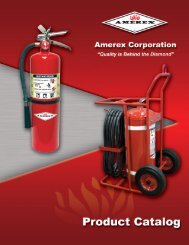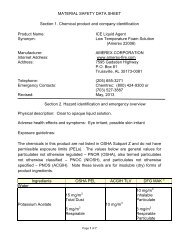ATC Foam Concentrate.pdf - Amerex Corporation
ATC Foam Concentrate.pdf - Amerex Corporation
ATC Foam Concentrate.pdf - Amerex Corporation
You also want an ePaper? Increase the reach of your titles
YUMPU automatically turns print PDFs into web optimized ePapers that Google loves.
MATERIAL SAFETY DATA SHEET<br />
Section 1. Chemical product and company identification<br />
Product Name:<br />
AMEREX 3x3 <strong>ATC</strong> AR-AFFF<br />
Synonym: 3x3 <strong>ATC</strong> ; <strong>Amerex</strong> part no. 21549<br />
Chemical Name:<br />
N/A This product is a mixture<br />
C.A.S No.:<br />
N/A This product is a mixture<br />
Chemical Formula:<br />
N/A This product is a mixture<br />
EINECS Number:<br />
N/A This product is a mixture<br />
Use of this product: The intended use of this product is as a fire extinguishing agent.<br />
Manufactured For:<br />
Internet Address:<br />
Address:<br />
<strong>Amerex</strong> <strong>Corporation</strong><br />
www.amerex-fire.com<br />
7595 Gadsden Highway<br />
Birmingham, AL 35173-0081<br />
Telephone: (920) 593-9445<br />
Emergency Contacts: Chemtrec: (800) 424-9300 or (703) 527-3887<br />
Revised: July 2012<br />
Section 2. Hazard identification and emergency overview<br />
Human Exposure:<br />
Product:<br />
EU Classification: Xi Irritant<br />
R Phrases: 36 Irritating to eyes<br />
S Phrases: 2 Keep out of reach of children<br />
24 Avoid contact with skin<br />
26 In case of contact with eyes, rinse immediately with copious amounts<br />
of water and seek medical advice.<br />
Components:<br />
Diethylene Glycol Monobutyl Ether:<br />
EU Classification Xi Irritant<br />
R Phrases 36 Irritating to eyes<br />
S Phrases 2 Keep out of reach of children<br />
24 Avoid skin contact<br />
26 In case of contact with eyes, rinse immediately with copious amounts
of water and seek medical advice<br />
Limit Values for Exposure:<br />
Diethylene Glycol Monobutyl Ether:<br />
OSHA PEL (General Industry) 8 hour TWA: None established<br />
MAK (DE) Limit Value: 100 mg/m 3<br />
Short term exposure limit value<br />
(8 times, 5 minutes): 200mg/m 3<br />
Neither this product nor any of the ingredients contained in it have been listed as carcinogenic by the National<br />
Toxicology Program IARC, or OSHA. As part of good industrial and personal hygiene and safety procedure,<br />
avoid all unnecessary exposure to chemical substances and ensure prompt removal from skin, eyes, and<br />
clothing<br />
Signs and Symptoms:<br />
Acute Exposure:<br />
Eye Contact:<br />
Skin Contact:<br />
Inhalation:<br />
Ingestion:<br />
Chronic Overexposure:<br />
May cause mild to moderate transient irritation<br />
May cause mild transient irritation and/or dermatitis<br />
Not a normal route of entry<br />
Irritating to mucous membranes<br />
Possible systemic and motor disorders, diethethylene glycol<br />
monobutyl ether did not interfere with reproduction; however,<br />
body weights of newborn animals were decreased.<br />
Medical conditions generally aggravated by exposure: Diseases of the kidney and liver.<br />
For Environment:<br />
As much as possible, keep from being washed into surface water.<br />
Section 3. Composition/information on ingredients<br />
Ingredient Name:<br />
Proprietary mixture consisting of hydrocarbon surfactants, complex<br />
carbohydrates, inorganic salts, solvent and water<br />
Chemical Formula:<br />
N/A - This is a mixture<br />
C.A.S. No.:<br />
N/A - This is a mixture<br />
EINECS Number:<br />
N/A - This is a mixture<br />
Concentration, Wt. %:
Ingredient Name:<br />
Diethylene Glycol Monobutyl Ether (a)<br />
Chemical Formula:<br />
C 4 H 9 O(CH 2 CH 2 O) 2 H<br />
C.A.S. No.: 112-35-5<br />
EINECS Number: 230-961-6<br />
Concentration, Wt.%: 12%<br />
Hazard Classification: See section 2<br />
(a) This chemical is subject to reporting requirements of SARA Title III Section 313 and 40CFR Section 372<br />
Section 4. First aid measures<br />
Eye Exposure:<br />
Skin Exposure:<br />
Inhalation:<br />
Ingestion:<br />
Irrigate eyes at eye wash station and repeat until pain free. Seek medical attention<br />
immediately.<br />
In case of contact, wash with plenty of soap and water. If irritation persists seek<br />
medical attention.<br />
If respiratory irritation or distress occurs remove victim to fresh air. Provide oxygen if<br />
breathing is difficult. Seek medical attention if irritation develops or persists.<br />
Do not induce vomiting. If victim is alert, give liquids such as milk or water. Seek<br />
immediate medical attention. Do not leave victim unattended. To prevent aspiration of<br />
swallowed product, lay victim on side with head lower than waist.<br />
Medical conditions possibly aggravated by exposure: Inhalation of product may aggravate existing chronic<br />
respiratory conditions.<br />
Section 5. Firefighting measures<br />
This product is an extinguishing media. No special protective equipment is required for fire fighters.<br />
Insensitive to mechanical impact or static discharge.<br />
HMIS (hazardous materials identification system) rankings (as liquid):<br />
health = 3, flammability = 0, reactivity = 0, personal protective equipment: eye and skin protection (see<br />
Section 8).<br />
Section 6. Accidental release measures<br />
For personal protection: Prevent skin and eye contact, see Heading 8<br />
Clean up: Use an absorbent material, to include but not be limited to, diatomaceous earth, kitty litter, or saw<br />
dust, and sweep up. See Heading 12<br />
Section 7. Handling and storage
Avoid eye, respiratory, and skin exposure. Use appropriate PPE (personal protective equipment) when<br />
handling, and wash thoroughly after handling (Section 8). Keep product in original container until packaging<br />
for use as extinguisher. Clean used equipment before storage. Use this product only in well ventilated areas.<br />
Do not mix with other extinguishing agents.<br />
Section 8. Exposure controls/ personal protection<br />
Respiratory protection:<br />
None expected to be needed, mechanical ventilation is recommended<br />
Hand Protection:<br />
Use chemical resistant gloves when handling the product<br />
Eye protection:<br />
Chemical goggles are recommended<br />
Skin protection:<br />
Standard fire-fighting equipment should provide all necessary protection<br />
Section 9. Physical and chemical properties<br />
Appearance: Liquid light brown color; mild sweet odor<br />
Solubility: Completely soluble in water<br />
Flammability: Non -flammable<br />
Flash point: Does not flash<br />
Vapor density (Air = 1): Not determined, but
Product:<br />
The toxicity of the product mixture has not been determined<br />
Components:<br />
Diethylene Glycol Monobutyl Ether<br />
Toxicity Data: Oral (rat) LD 50 5,660 mg/kg<br />
Oral (rat) LD 50 9,626 mg/kg (EINECS ESIS)<br />
Dermal (rabbit) LD 50 4,000 mg/kg<br />
Dermal (rabbit) LD 50 2,764 mg/kg (EINECS ESIS)<br />
Irritation Data: Eye (rabbit) 20 mg/day Moderate (EINECS ESIS)<br />
Eye (rabbit)<br />
Highly irritating (EINECS ESIS)<br />
Skin (rabbit)<br />
1000 mg/kg/day Moderate with edema,<br />
fissuring, leathery<br />
appearance (EINECS ESIS)<br />
Target organs: Kidney, blood, liver, lungs, gastrointestinal, spleen<br />
Section 12. Ecological information<br />
Ecotoxicity:<br />
Components:<br />
Diethylene Glycol Monobutyl Ether<br />
Fish Lepomis marcrochinus: LC 50 (96 hrs.) 1,300 mg/L<br />
Carassius auratus: LC 50 (24 hrs.) 2,700 mg/L<br />
Daphnids, Daphnia magna: EC 50 24 hrs.) 3,184 mg/L<br />
Algae, Scenedesmus subspicatus: EC 50 (96 hrs.) >100 mg/L<br />
Mobility<br />
Diethylene Glycol Monobutyl Ether<br />
Should not partition from a water column to organic matter contained in sediments and suspended<br />
solids.<br />
Persistence/ Degradability:<br />
Diethylene Glycol Monobutyl Ether:<br />
Indirect photodegradation is about 50% in 3.5 hours<br />
Aerobic degradation with adapted activated sludge is 60% after 28 days<br />
COD = 2080 mg/g of substance<br />
BOD 5 = 250 mg O 2 /g substance<br />
Theoretical oxygen demand = 2.17 mg/mg<br />
Bioaccumulation:<br />
Diethylene Glycol Monobutyl Ether:<br />
Should not bioaccumulate.<br />
Section 13. Disposal considerations<br />
As much as possible, keep from being washed into surface water, see Heading 12. Dispose of in compliance<br />
with national, regional, and local provisions that may be in force.<br />
Section 14. Transportation information
This product is not a hazardous material under U.S. Department of Transportation (DOT) 49 CFR 172, and is<br />
not regulated by the DOT, IMO, lATA, RID/ADR, or Canada's TDG.



